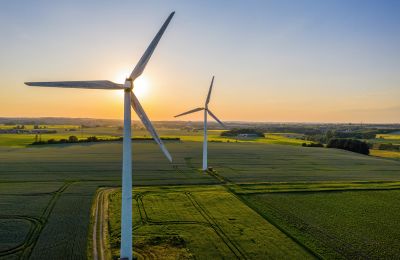Falling prices and more exports


Electricity. According to E-Control, much more electricity will be generated by 2030. Austria will establish itself as a net exporter. Consumers will also benefit from this. Johannes Mayer, E-Control, on PV expansion.
Austria's electricity supply is excellently positioned for the coming years. This is the conclusion of the latest monitoring report from the regulatory authority E-Control. It analyzed data from recent years and conducted numerous simulations of electricity generation and distribution up to 2030. The best news for electricity customers: Prices are expected to fall steadily. For many existing customers, there will be ongoing, small downward adjustments. Households benefit from the cost reductions more quickly the more often they switch providers.
More good news: Electricity customers don't have to worry about a widespread and prolonged power outage, a blackout. "We don't see this danger in the coming years either," says E-Control board member Alfons Haber.
Earning in Europe
A particularly encouraging development in recent years has been the expansion of renewable energy. "In photovoltaics, we are about three years ahead of our expansion targets," says Haber. E-Control sees a slight need to catch up in run-of-river power and wind power. However, the expansion targets set out in the Renewable Energy Expansion Act can be achieved. In the case of photovoltaics, the cuts in government subsidies, which have been criticized by the industry, do not jeopardize the expansion path.
“We have made so much progress in the last two years that a leisurely pace is now sufficient,” says Johannes Mayer, head of the Economics Department at E-Control.
Thanks to favorable weather conditions (especially good water supply), Austria exported a net 10 percent of its own electricity production in 2024. In the future, the country will establish itself as a net exporter, says Haber. However, it will still have to import electricity during the winter months. Connectivity with the European electricity market is therefore very important.
The expansion of the continental grids will lead to cheap electricity production throughout the EU. Local conditions such as periods of low solar and wind power generation can thus be compensated for. The grid expansion will pay off for Austria, says Haber: "In Germany, there is a generation shortage. There is high demand for electricity there. If we can serve this market, we will benefit."
By 2030, Austria will be able to cover 95 percent of its electricity needs with renewable energies. Gas-fired thermal power plants will continue to be necessary for the remainder. Some energy suppliers are questioning how these can be operated economically in the future if they have limited operating hours. E-Control is convinced that a new market model (capacity market) is not necessary. Extending the operating life of aging gas-fired power plants is definitely worthwhile.
Favorable times
To manage peak loads in the grid, E-Control is focusing on increasing consumption flexibility. In the future, grid charges will also provide sufficient incentives to adjust electricity consumption to the timing of generation.
The price difference in wholesale electricity between more expensive and cheaper hours is becoming increasingly wider, says Mayer. Private customers can benefit from shifting their consumption to cheaper times by using so-called floater tariffs. Currently, only a single-digit percentage of all metering points have such a contract, which involves fluctuating electricity costs depending on the market price.
"We have made so much progress in recent years that a leisurely pace is now sufficient" Johannes Mayer, E-Control, on PV expansion
Facts
82 terawatt hours
Domestic power plants generated electricity in 2024. Only 75 TWh was consumed domestically. 95 percent of the electricity produced came from renewable energy sources.
Price forecast
Wholesale gas prices are currently between €35 and €40 per megawatt hour. By 2028, the price should drop to €30. This translates into falling electricity prices. The current price is €97. E-Control expects €87 in 2026 and €74 in 2028.
Seasonal difference
For summer 2026, 73 euros are expected, for winter 101 euros
courier
energynewsmagazine





